While it is largely forgotten by many people, the SIG P250 pistol may have been one of the most important handguns in the company’s history.
Not because of what it accomplished itself – but because of what it inspired.
By most standards, the P250 was a lackluster offering from SIG Sauer. However, it paved the way for the incredibly popular P320 handgun and the adoption of the same gun by the U.S. military in the form of the M17 and M18 pistols.
Introduction of the P250
SIG Sauer introduced the P250 pistol in October 2007 at the International Association of Chiefs of Police convention.
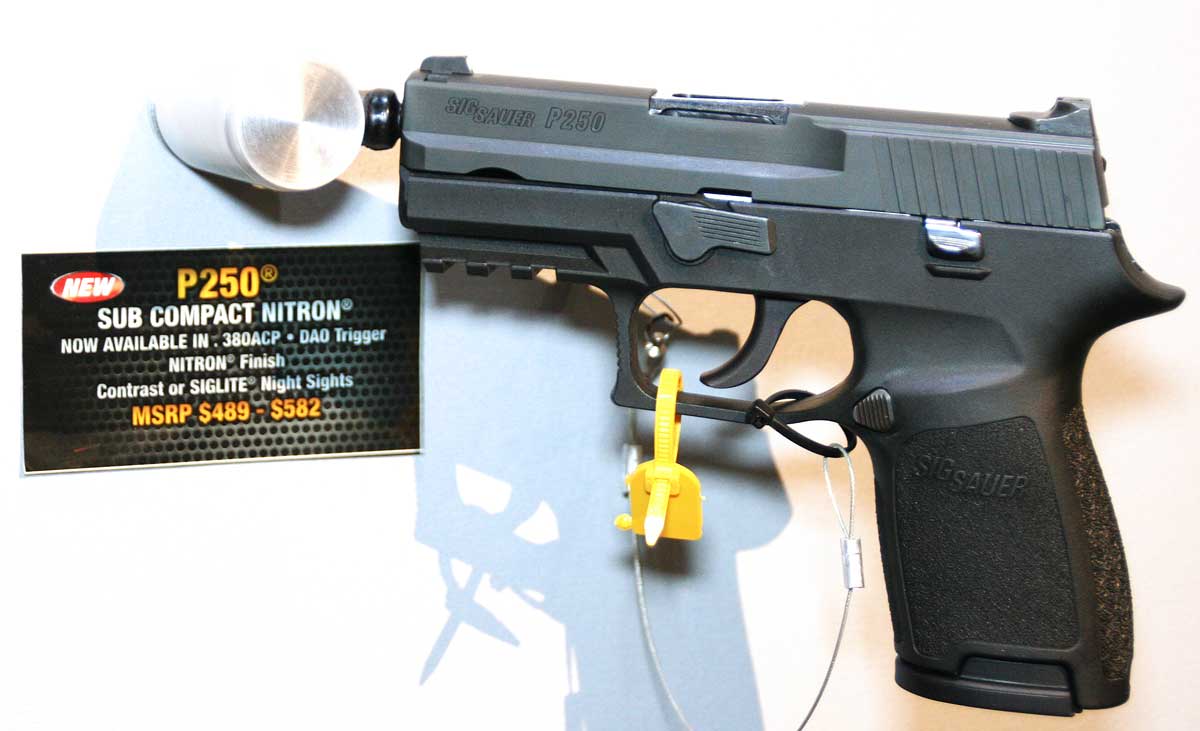
The IACP convention is an annual meeting of law enforcement administrators that has an associated trade show. Few significant gun announcements are made at the event since the audience isn’t really a pro-gun crowd.
SIG, however, hoped to market the P250 to law enforcement due to its very special features that seemed able to reduce department budgets without compromising reliability. SIG believed that the gun would appeal to law enforcement administrators and went with the IACP launch.
P250 Interchangeable Modules
What kind of features did the P250 have that might catch the interest of a law enforcement administrator?
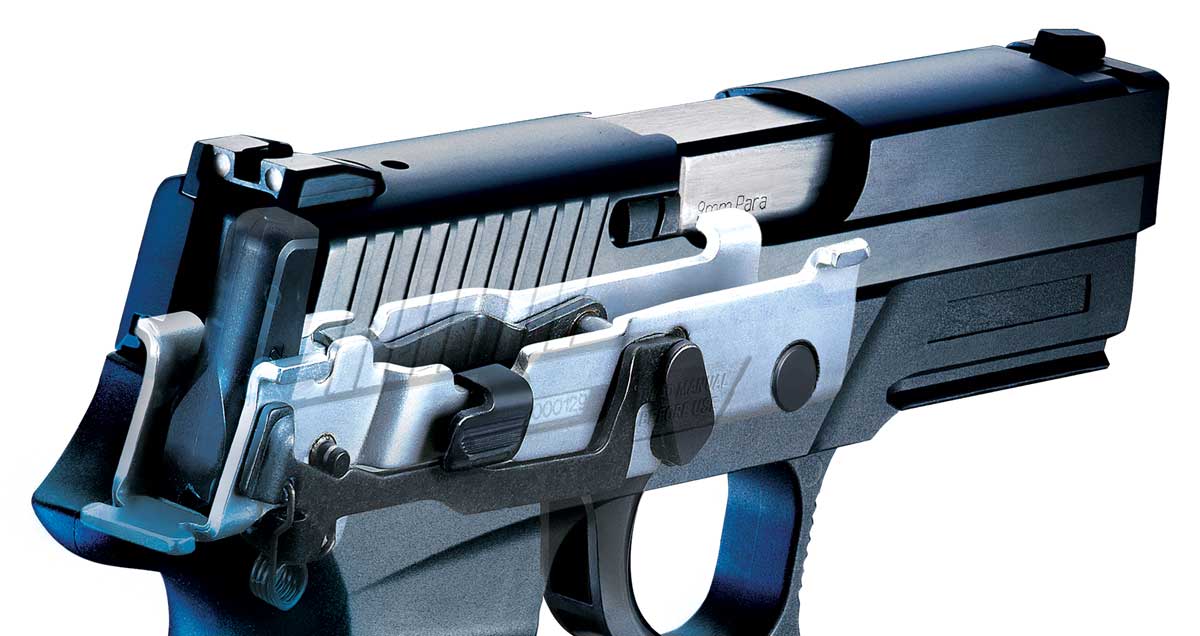
The biggest features was the design that made the gun’s internal chassis the gun’s receiver. In a legal context, the receiver is the part of a firearm that is serial numbered and requires transfer paperwork.
For many pistols, the frame – the grip assembly on which the slide rides – is the part with the serial number. For the SIG P250, a removable metal insert was the serial numbered part, not the polymer grip module. The metal chassis was named the gun’s fire control unit by SIG Sauer.
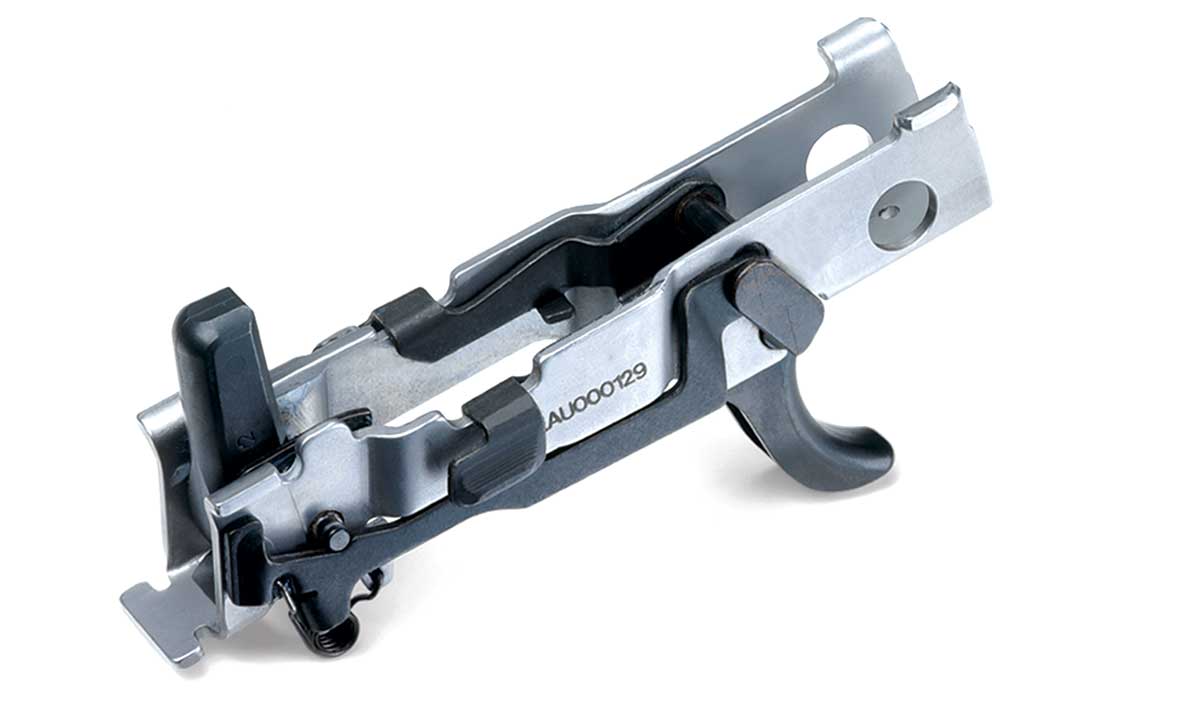
An end user would use the gun the exact same way he or she would use any other pistol. If, however, they wanted a more compact grip, the internal chassis could be pulled from one grip module and dropped into another.
Since the grip modules were simple polymer parts that were not considered firearms, they could be made inexpensively then sold and shipped without any onerous paperwork. For a department, this was potentially a huge deal.
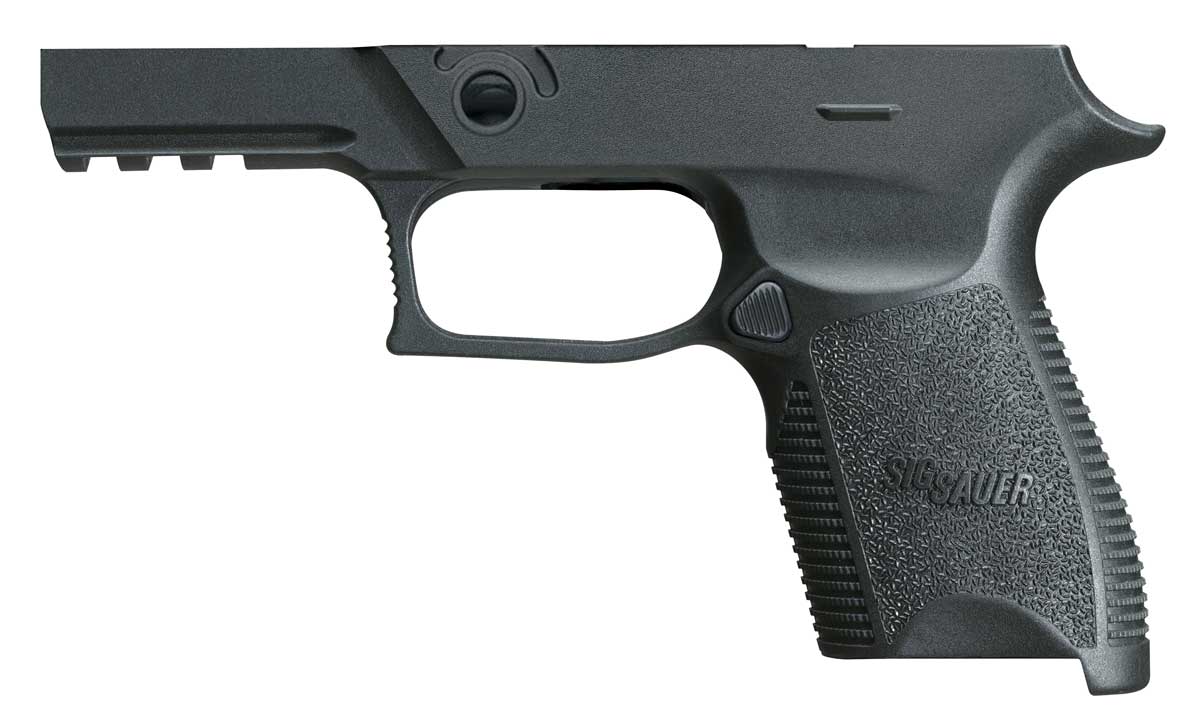
Consider that police departments employ incredible diverse people of all hand sizes. What fits one officer may be wholly inappropriate for another. Having a single chassis that could drop into any one of several dozen different sized meant the department could improve officer performance for the cost of a few dollars per module rather than hundreds each for different sized pistols.
The use of modules also appealed to departments because there are different handgun needs within the agency. A uniformed patrol officer can easily carry a full-size pistol in an open security holster. The same gun would be a burden for many officers to conceal in an investigative assignment.
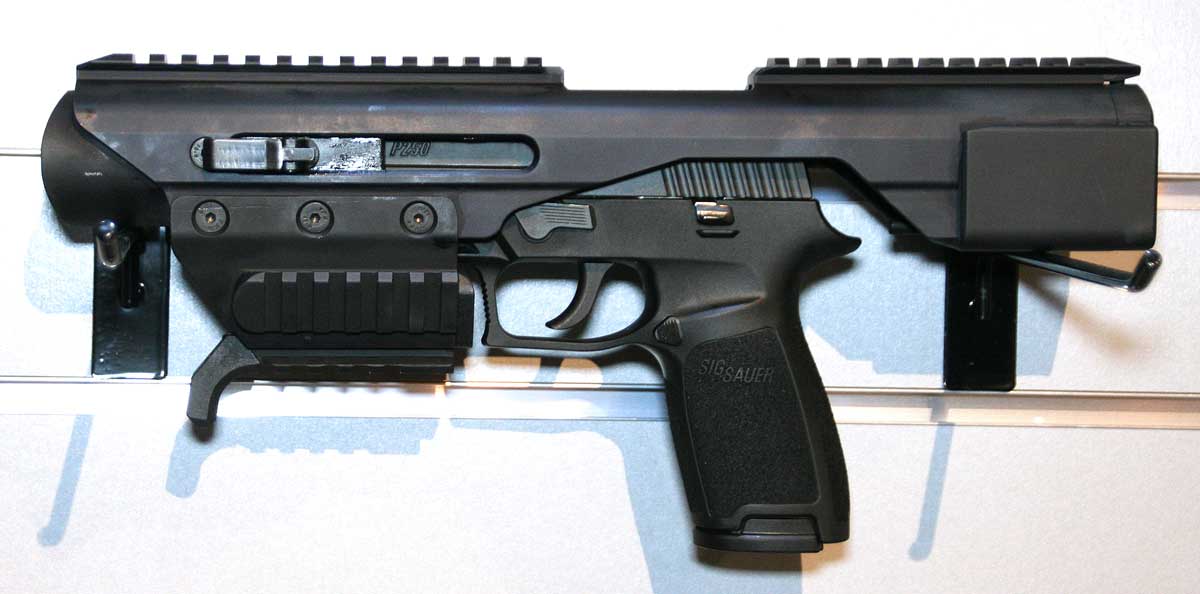
Traditionally, that meant the agency would need to have a second set of firearms in its inventory for detectives. Some departments might have further handgun requirements for its vice squad or SWAT breaching officers that would require a third or fourth set of handguns.
The P250 aimed to change all of that. SIG intended that a department could buy one gun with a few extra grip modules. An officer could then be issued a single weapon that changed sizes as the assignments changed.
Ron Cohen Interview
SIG didn’t limit its modularity pitch to law enforcement agencies. In an appearance on the Cam and Company radio show at the 2008 SHOT Show, the company’s CEO and president, Ron Cohen, appeared to talk about the pistol.
“It’s not a gun; it’s a system.”
SIG Sauer SEO and President Ron Cohen, Cam & Co. radio show January 2008
Cohen and Adam Pinchot, a SIG employee, then demonstrated how the grip module can easily be changed for another of a different size.
Cohen stressed that no single gun can fit all people well. As the P250 is not a “single gun,” it allows “the dealer to adapt it to your requirement,” he said. The P250 offers “a suitcase of options” that “lets you change caliber and size at will.”
Cohen promised, “There is no compromise on quality, accuracy, or safety.” Yet, Cohen said the MSRP on the P250 is “around $650,” which makes it one of the least expensive guns Sig Sauer has brought to market. MSRP on the SIG P250 ultimately landed at $699.
Hammer Fired
SIG Sauer made it’s handgun reputation on reliable, hammer-fired pistols like the P220 and P226. SIG bet that it could arrest the progress of the striker-fired revolution that had eaten much of its handgun sales.
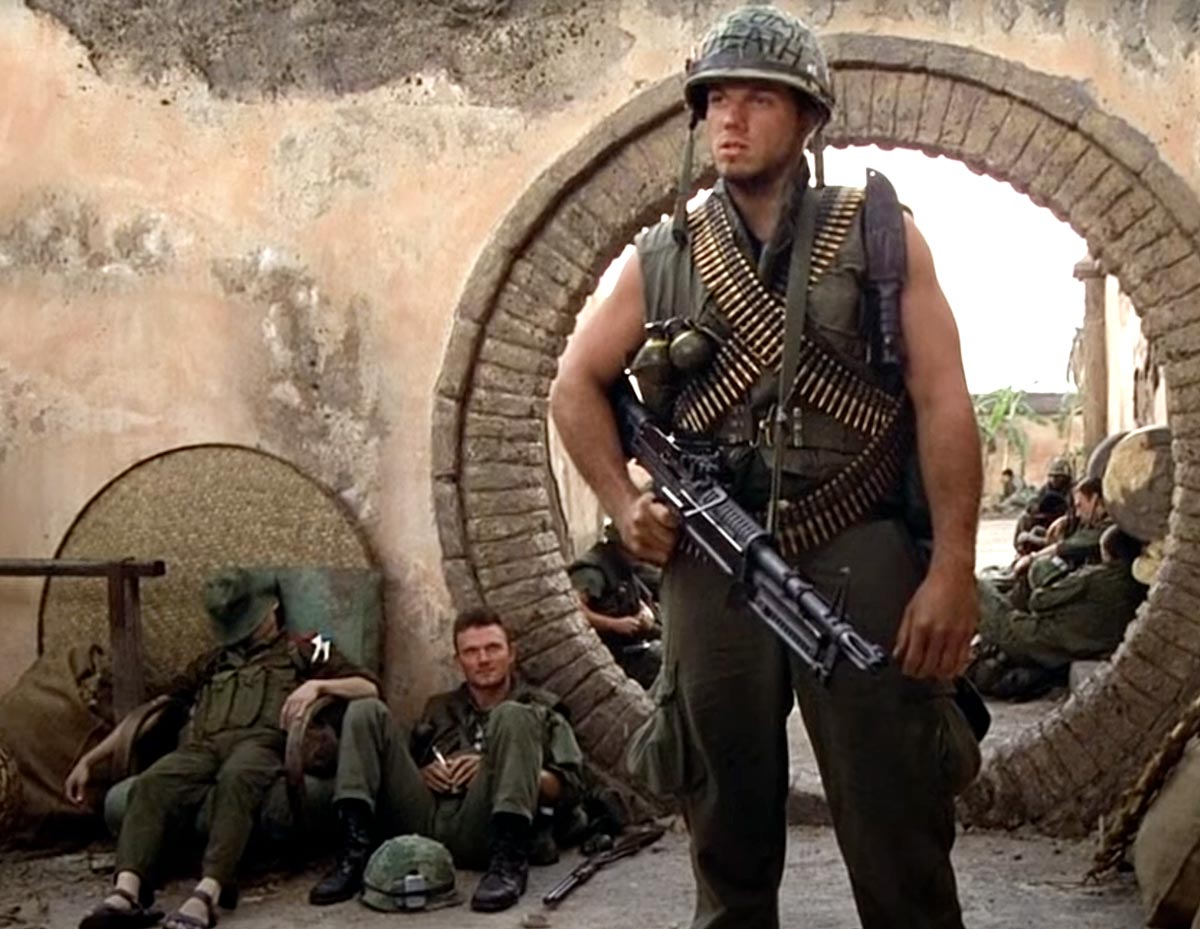
The P250 was a double-action-only (DAO) pistol with a hammer firing system. Sadly, the system was the longer DAO system the company often used instead of the superior double-action Kellerman (DAK) trigger that was an option on the company’s metal frame pistols.
While SIG undoubtedly saw this as a selling feature to under-informed police administrators who were concerned about liability from the striker-fired boogeyman. It does not appear the bet paid off as many agencies continued migrating to Glock and Smith & Wesson M&P pistols. The pro-SIG agencies largely continued to purchase traditional guns like the P226.
Additional Features
By 2012, the company was fully invested in the P250 platform. This seems to have been the high water mark for the pistol, though it is my understanding that the company was already working on the gun’s replacement.
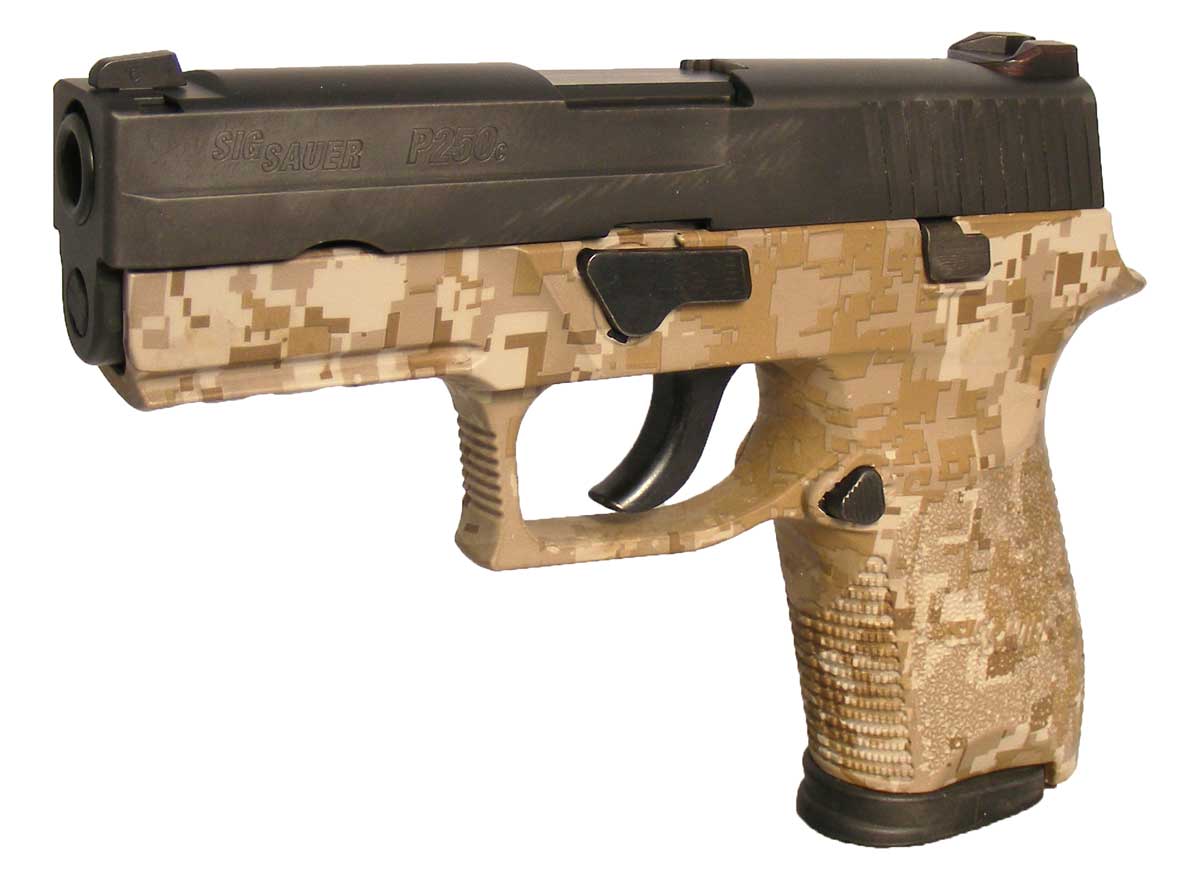
The P250 guns were offered in three sizes and five centerfire calibers for a total of 14 different configurations available from the factory. Further customizations could be accomplished with the choice of three different grip widths and two trigger reach options.
Centerfire caliber options included:
- .380 ACP
- 9mm (aka 9×19 or 9mm Parabellum)
- .357 SIG
- .40 S&W
- .45 ACP
From the factory, you could purchase the gun with either Contrast or SIGLITE Night Sights. The Contrast sights were the company’s non-illuminated dot and post sights. SIGLIGHT Night Sights used a tritium-powered 3-dot arrangement.
SIG Sauer also offered a rimfire version of the gun chambered for the .22 LR. Additional information about that model is below.
P250 Specifications
The full size SIG P250 had a stainless steel slide with a black Nitron finish, polymer grip and a M1913 accessory rail.
| calibers | 9mm, .357 SIG, .40 S&W, .45 ACP |
| magazine capacity | 9mm – 17 rounds, .357 SIG & .40 S&W – 14 rounds, .45 ACP – 10 rounds |
| barrel length | 4.7″ |
| weight | 29.4 oz (unloaded) |
| sights | contrast or night sights |
| MSRP | $558 (January 2012) |
The P250 Compact was the middle size of the line up. Like the larger gun, it featured a Nitron-finished stainless steel slide, polymer grip module, a DAO trigger and an accessory rail. It added the option of a fifth chambering: .380 ACP.
| calibers | .380 ACP, 9mm, .357 SIG, .40 S&W, .45 ACP |
| magazine capacity | .380 ACP, 9mm – 15 rounds, ,357 SIG, .40 S&W – 12 rounds, .45 ACP – 9 rounds |
| barrel length | 3.9″ |
| weight | 26.5 oz (unloaded) |
| sights | contrast or night sights |
| MSRP | $558 (January 2012) |
Rounding out the P250 line was the Subcompact model. Although smaller, it enjoyed all of the same features of the Compact save one: the Subcompact did not have an accessory rail.
| calibers | .380 ACP, 9mm, .357 SIG, .40 S&W, .45 ACP |
| magazine capacity | .380 ACP, 9mm – 15 rounds, ,357 SIG, .40 S&W – 12 rounds, .45 ACP – 9 rounds |
| barrel length | 3.6″ |
| weight | 24.9 oz |
| sights | contrast or night sights |
| MSRP | $558 (January 2012) |
Rimfire Version
In addition to the centerfire pistols, SIG offered a blowback-operated .22 LR version of the P250 called the P250-22. These units used the same fire control unit and grip module as the regular guns. However, the P250-22 had a new slide assembly.
According to SIG, the P250-22 was compatible with the centerfire pistols. So, you should be able to swap a 9mm slide assembly onto a P250-22 frame without issues.
The P250-22 had adjustable sights and a 10-round magazine.
Other Variants
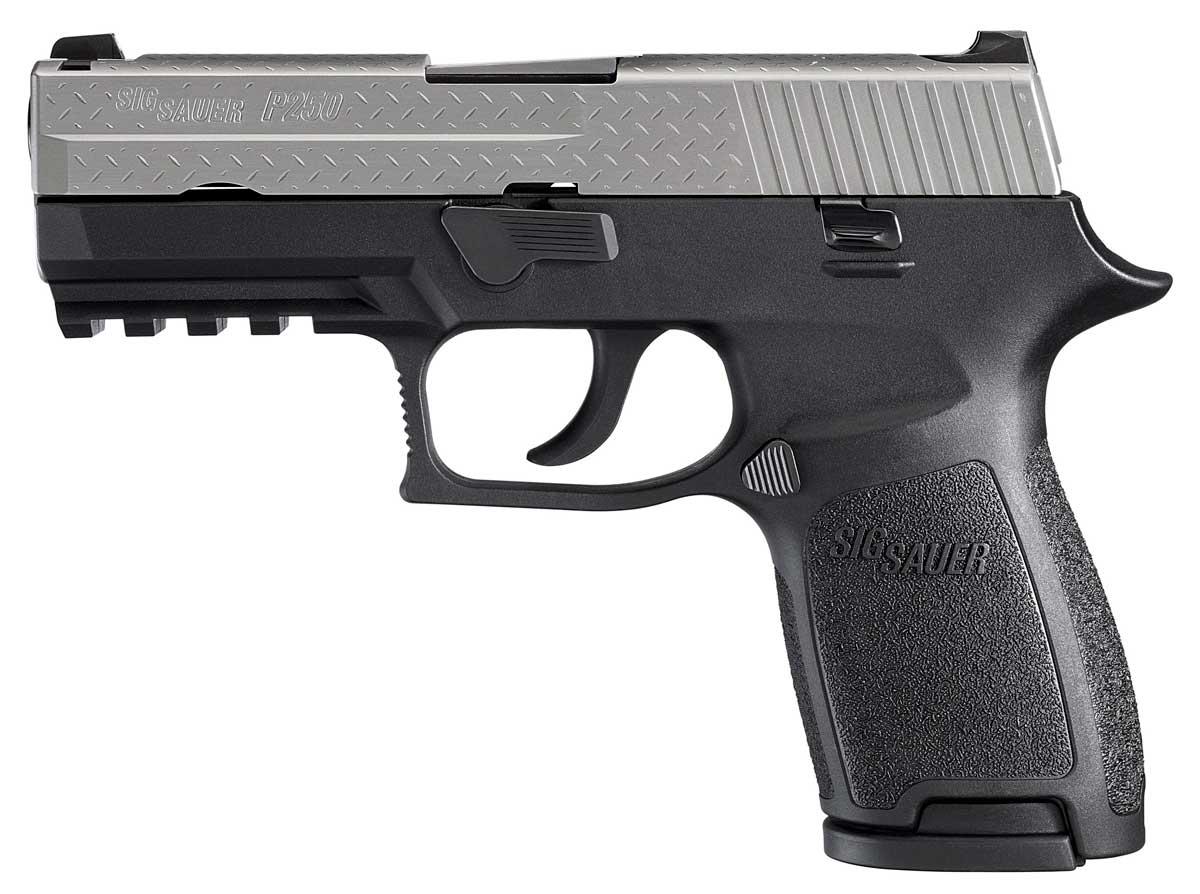
SIG Sauer offered a number of variants in the P250 line. These were not always catalog items but instead would appear on the company’s website or as special runs for distributors.
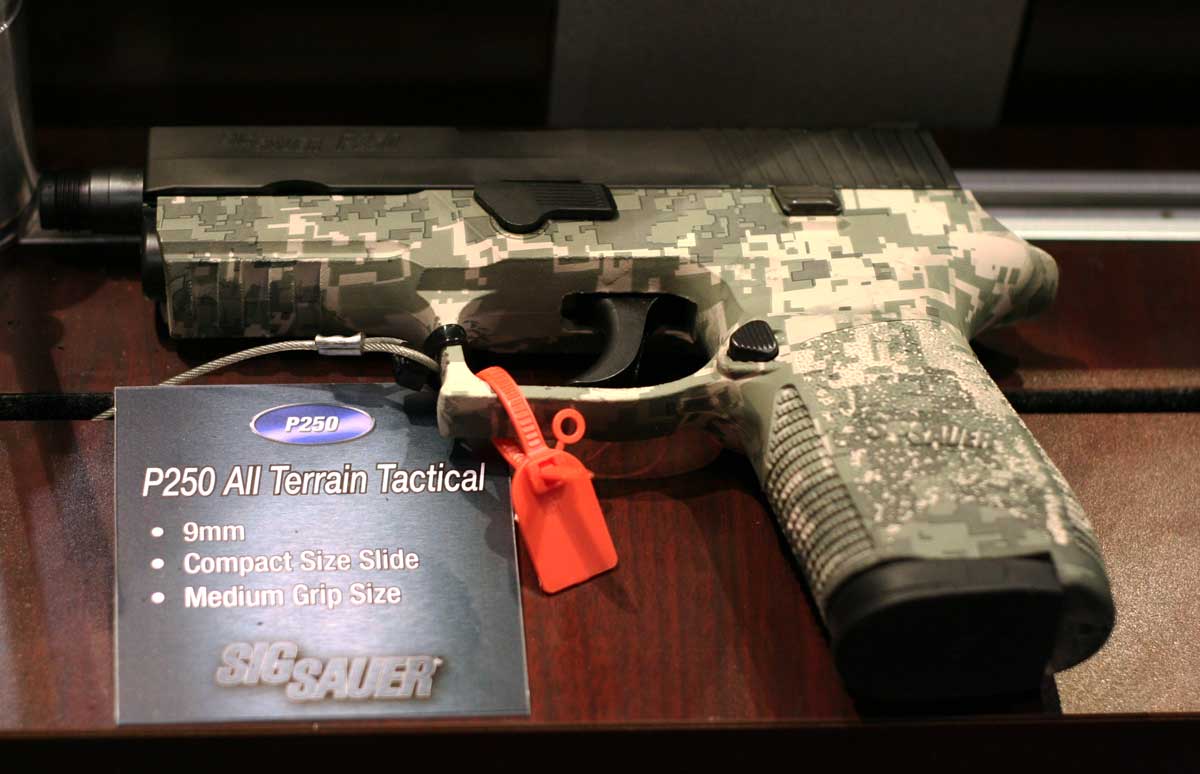
For example, SIG offered the full and compact P250 pistols with a bright stainless finish on the slide. These were known as Two Tone models.
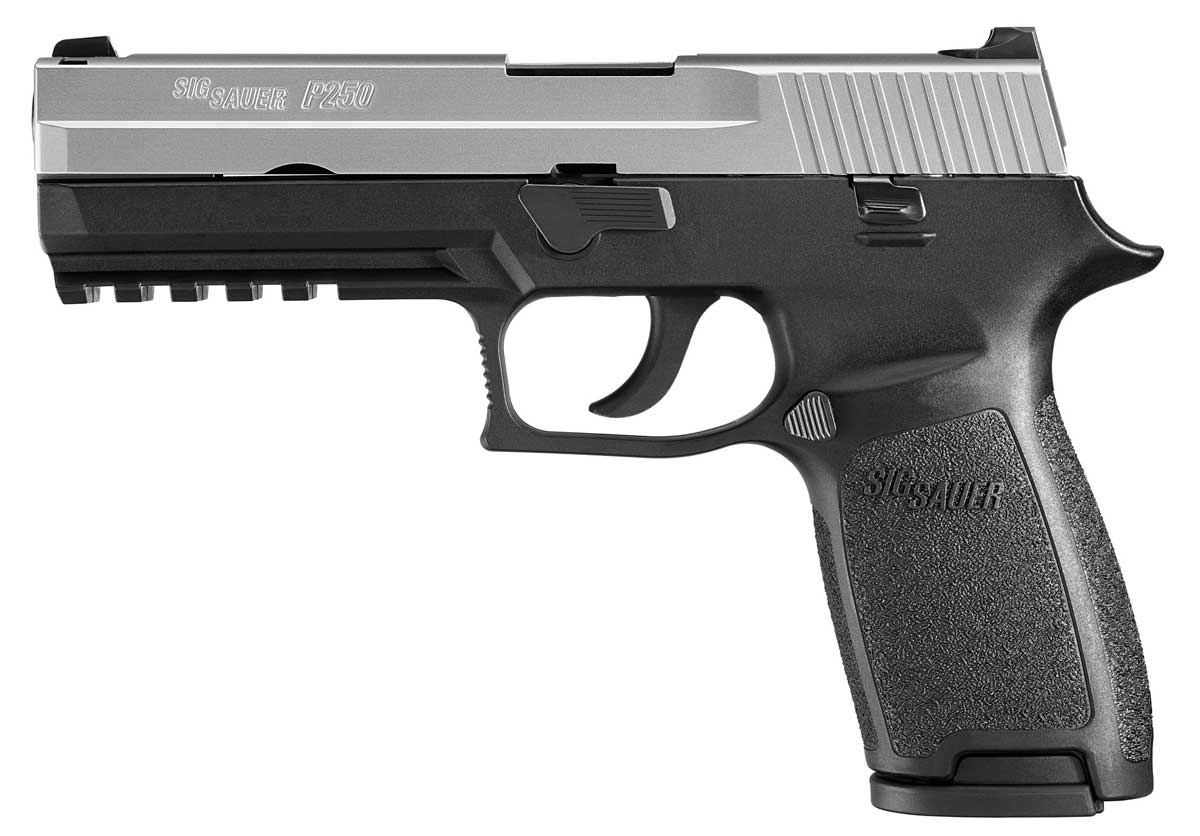
Additionally, there were grip modules offered with a desert-type Digital Camo and an All Terrain Digital camo pattern.
Performance
The P250 pistols I shot were all reliable and accurate. To me, the trigger pull was surprisingly easy for a DAO gun, but the pull seemed much longer than necessary for a modern defensive firearm.
One of the issues many people have with the traditional SIG pistols is the trigger reach. If you have long fingers, the P220/226 lines of pistols are no problem. Ditto for the P250.
However, if you have small or medium sized hands, you really needed the Reduced Reach Trigger for optimum shooting. I much preferred the Reduced Reach Trigger on my P250. For what it is worth, I had the same thing installed on my P226.
My P250 was reliable with all kinds of ammunition include the SIG Sauer defensive ammo.
P250 Adoption
You might ask who or what law enforcement agencies adopted the P250 as a duty firearm.
While we may never know how many departments selected the gun for a service weapon, the number seems to be quite small.
Anecdotal evidence suggests that departments looking for a polymer pistol tended to stick to Glock and Smith & Wesson M&P pistols. Further, agencies that were brand loyal to SIG, by and large, held on to the classic P220/226 models. It probably didn’t help that SIG continued to develop the classic guns like the P226 E2.
Nevertheless, there were some agencies that gave the gun a serious look. Most notoriously was the U.S. Federal Air Marshal Service (FAMS).
Air Marshal Scandal
In the fall of 2009, the U.S. Federal Air Marshal Service (FAMS) announced the SIG Sauer P250 as the new duty gun for their agents.
Chambered in the highly potent .357 Sig cartridge, the FAMS upgraded to the P250 from the SIG Sauer P229. Specifics of the contract were not released by FAMS.
However, in April of 2014, Robert Bray, the director of the Federal Air Marshal Service resigned from that agency amid allegations of illegal gun sales going on during his watch. According to Fox News:
“Poulos [an FAMS supervisor] is accused of using the agency’s federal firearms license and his relationship with gun manufacturer Sig Sauer (sic) to obtain discounted and free guns. He then provided them to high-up agency officials for their personal use..”
According to the same Fox News report, US Representative Richard Hudson (NC) claimed in a letter that:
an Air Marshal supervisor “may have accepted free firearms that were offered because of the employee’s official position in 2010, at a time when such firearms were being tested by FAMS for possible future procurement.”
SIG Sauer representatives declined a request from GunsHolstersAndGear.com to comment on the matter.
Much of the information related to the FAMS is considered classified. Bray’s timing of his resignation essentially prevented public disclosure of the results of the investigation. It is not known what, if any, wrongdoing was uncovered. In a phone interview with CNN, Bray denied any wrongdoing.
Influence on the P320
While the P250 may not have made history in the law enforcement market, it would ultimately make a giant impact on the gun world through its influence on the striker-fired P320.
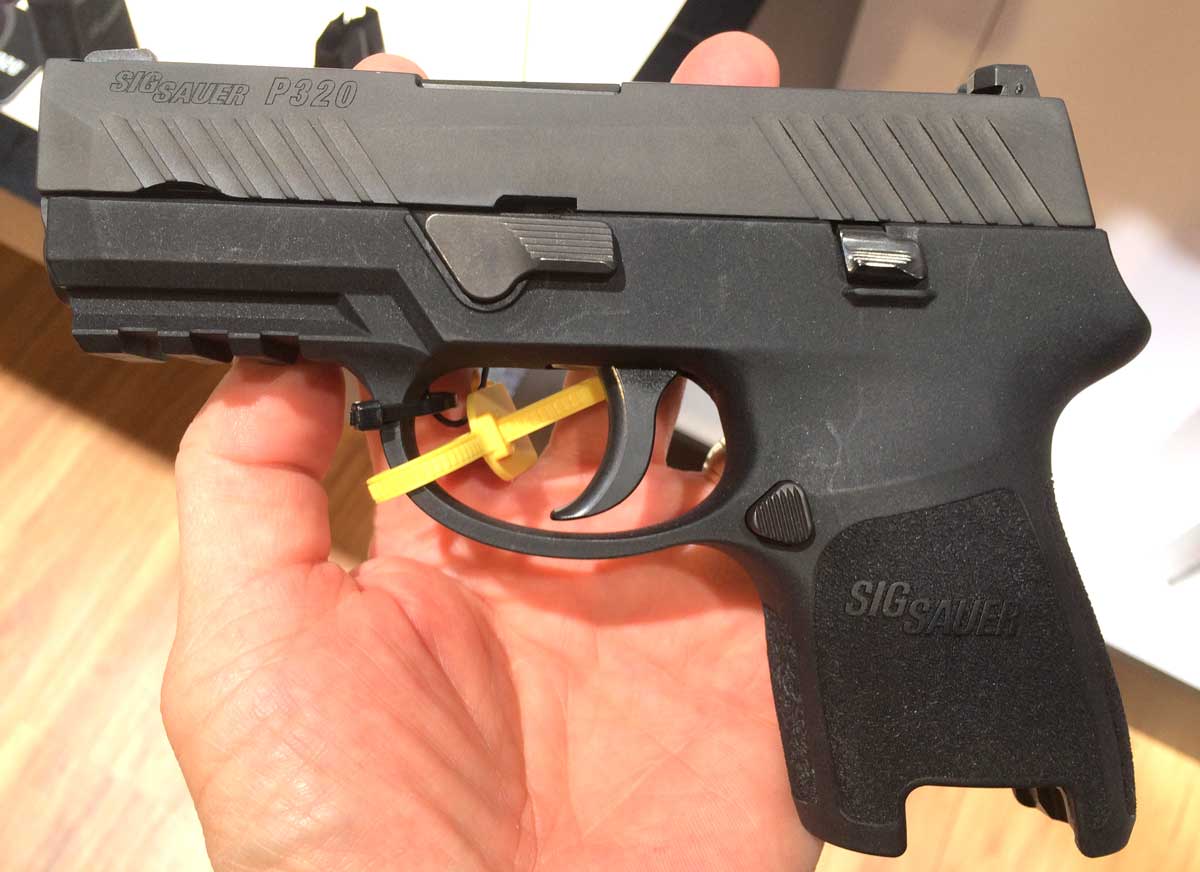
I have to admit that I was underwhelmed when I first saw the SIG P320 at the 2014 SHOT Show. My thought was that the company merely pulled the hammer system from the P250 and dropped in a striker assembly in some sort of cost-savings measure.
While I can’t say that money never entered the minds of the folks at SIG Sauer, I can say that the P320 was an evolutionary advancement of the modular system the P250 developed.
The P320 really is a refined, premium version of the P250 pistol. SIG got a lot of things right with the P250 even if the shooting public wasn’t enamored with the gun. As soon as the company dropped in the striker unit, people began to flock to the pistol.
Compatibility with P320
As I’ve described, the P250 served as the test platform for the P320. But, are the parts interchangeable?
Let’s take a look at some of the main components.
Are Grip Modules Interchangeable?
Yes. You can swap the modular fire control unit between any grip module made for either pistol. In fact, I highly recommend looking at the carry-sized module made for the Wilson Combat P320 pistols.
Are Magazines Interchangeable?
Yes. Mags are completely interchangeable between the P250 and P320 platforms.
Are Barrels Interchangeable?
Yes. I urge caution, however, to make sure you don’t mix barrels with the wrong ammo. I’d hate to see someone run into issues because of an oversight.
End of the Line
All good things come to an end, and the run of the P250 line died in 2017. The final centerfire P250 pistols ended production in 2016 with the .22 LR version of the pistol being the sole pistol left in the 2017 catalog. By the following year, the rimfire was removed from the catalog as well.
While the pistol had less than 10 years of service as a defensive firearm, its legacy will stretch on for decades.
The SIG P250 was the proving ground for the modular platform that would become the P320. Where the P250 was met with tepid approval, the P320 enjoys gushing praise.
I know many people who have purchased a P320. Further, many law enforcement agencies are selecting the new SIG for its impressive qualities.
Most significantly, the United States military forces have adopted the pistol as the standard sidearm of our combat troops. This alone ensures the gun will be a long-term success.
And that, I think, is the legacy of the P250. It may never be appreciated for its own accomplishments, but its descendants will leave a lasting impression on the shooting world.
Last update: May 14, 2021.
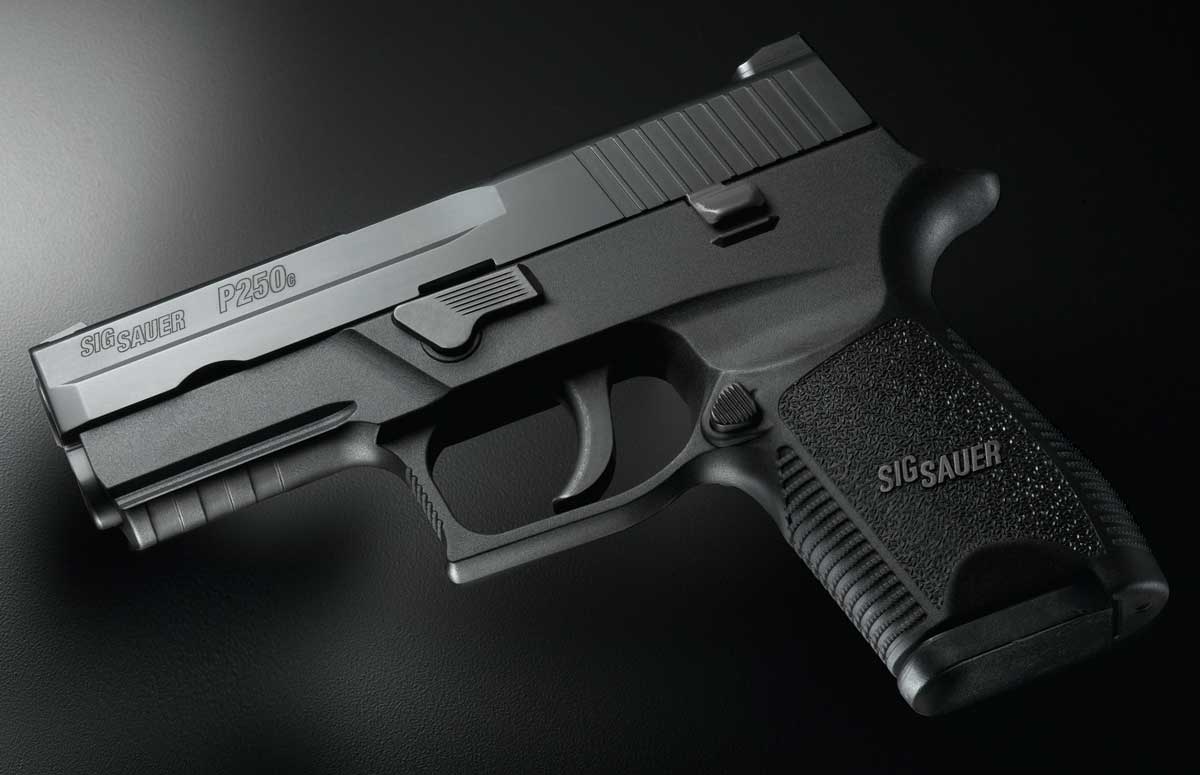
11 replies on “History of the SIG P250 Pistol”
I started off with the p 250 twosome in .40 cal. My first SIGS and my first DAO pistol, they came in a full size and sub compact. First trip to the range the full size was spot on, tight groups and after a few rounds i was also excited with the results of the sub compact, in all I was very happy with my choice to go build my P 250 arsenal. My first choice was the .45 in a compact, this way I would have all three sizes of grips and I could choose different calibers for the correct frame. received the grip and .45 kit and excitedly tried to put it together, I foUnd that I could not get the slide on the frame and after many attempts called Sig Sauer the next day. I got James on the phone and he informed my the I needed a different take down lever and O-ring, why wasn’t I informed of this when I purchased the kit? ten days later I got the package from SIG, again hurriedly unpacked and sat down to pit my new .45 together. I got it put together but now the slide was real difficult to pull back and when I did get it back it would not return with out some serious coaxing on my part. Called James again and again and again and a lot more, left messages and nothing. Called the company that I purchased all the Sigs from and canceled the .357 kit and told him if I cannot use this .45 for him to return my money and he could have his kit. He called sig and four days later James called and told me I would have to send the the entire .45 to Sig for repair, this also rendered both of my .40’s inoperable also and that sucked!!!
When I asked the turn around time I was told 2 weeks, yea I have a lot of confidence in that!!! So now instead of three SIGS, I don’t have any operable SIGS and I went from a high to less than excited with SIG SAUER so far
Thanks for the info on the twosom in 45 cal. We all get a bad apple sometimes but in reality do you like to have the flexability to change grips. From small to large depending on the need and requirement
That is one of the reasons I began with the Sig p250 series. Flexibility and a less expensive way to own multiple platforms with multiple calibers. I am sure that the issues with the 45 will be resolved and I can continue to expand my P250 series. I still live the way all of the pistols shoot and I have had zero problems with accuracy right out of the box. It is my belief that the extractor is the problem and my next visit to the range will confirm this hypotheses. Highly recommend the Sig twosum .45 cal. And Curio arms on gunsamerica had the best price by over $100.00 respond back if u want their contact info.
i purchased a sig p250 some months back and have been to a pistol range maybe 3-4 times. Made a attempt to zero the weapon only to find out it shoots way off target. No matter what approach I used without tampering with the sights I get no results.I am retired Military and have used the colt 1911 for years also the 9mm beretta. So shooters technique is not the problem what is your suggestion.
sincerely Fred Balliet
I think the clue to working out this problem is spelled out right in your comments. You state you “have used the colt 1911 for years “. Also I’d be willing to bet the Beretta you’re used to is the M9 9mm, correct? The problem is your trigger pull. The Colt is a single action and the Beretta is a single/double action. I’m sure you know it’s workings but just in case- single action needs to be cocked and in a “single action” the hammer is dropped when the trigger is pulled. Likewise the Beretta being a single/double action (which can actually be used as a traditional single action) has it’s hammer cocked by the firing mechanism thus becoming single action after the first shot (unless cocked first). You’re muscle memory is waiting for the recoil way before the full cycle of a true DAO (Double action only) occurs. The P250 almost feels like a dual stage trigger and takes some getting used to (I know, I own one). I’m sure once you get used to the trigger pull difference you will become just as proficient with the Sig as you are with the Colt. Trust me, You’ll like it! 🙂
Well I have since sold all of my Sig p250s.I practiced dry firing often and enthusiastically but never felt confident enough to continue carrying the weapon system. No matter how much work I did at the range, firing from the ready position never yielded satisfactory results. I did not have the necessary confidence that if needed I could draw and fire and hit what I need to hit. I now carry the XDM .45 ands after a prp trigger I get consistent bullseyes at 50 ft, that’s right 50 ft. For me the entire experiment of the p250 twosum sounded Good but in reality the dao killed it for me.
I’m really sorry to hear that. I understand your frustration as I also had a transition period. My other pistols being Colt 1911 and Defender, Browning hipower, Walther P38, Sig 229 and Scorpion and a recent addition- Rem R1 (I like the 1911) among others. Yet my daily carry is the Sig 250 compact 45acp in a fobus. I trust both my and my family’s life with it. It’s NEVER failed me yet! But you have to be confident in your carry choice. That’s a big part of the decision. Be safe my friend, times are precarious. 🙂